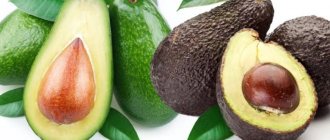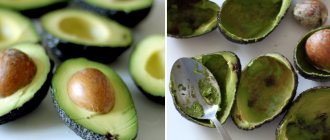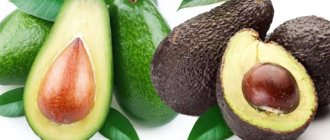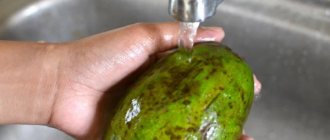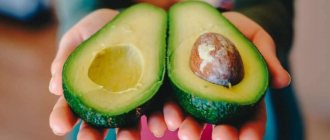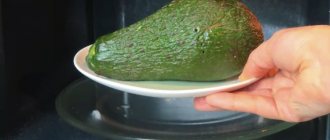Avocados don't start to ripen until they're picked from the tree, but the process happens pretty quickly after that.
Once ripened, you have a narrow window of time—usually a few days—before the fruit begins to spoil (1).
You may be wondering how to tell when an avocado has gone bad and is no longer ready to eat.
Here are 5 signs that your avocado has gone bad.
How do you know if an avocado has gone bad?
Which avocado is better?
The fruit is ripe if: If the dent remains, the fruit is frozen and may be rotten. If avocado
very hard - it
’s better
not to take it, because then you won’t feel any taste. If there are brown spots or dents on the peel, the fruit is rotten.
Interesting materials:
What is a silver spoon for on the first tooth? Why do you need a network card in a PC? What is a profile header for? Why do you need an auger juicer? What is a grill pan for? What is a frying pan for? Why do you need smart inversion? What is a nail topper for? What is an account for? Why do we need a waffle iron on the roads?
Blackened peel
Some avocados undergo distinct changes in skin color as they ripen, especially the Hass variety, which accounts for about 80% of avocados eaten worldwide (3).
When Hass avocados are not fully ripe, they have a bumpy, bright green skin. When ripe, it turns dark green or brown. If the skin looks almost black and the fruit feels soft when touched, it is overripe and probably spoiled.
Other varieties, including Zutano and Fuerte, retain their green skin color no matter how ripe they are. Use other methods, such as feeling for firmness, to determine whether they are ripe or spoiled.
Hass, the most common variety of avocado, has blackened skin when overripe or spoiled. However, other varieties retain their green color when overripe.
How does avocado poisoning occur?
The leaves, pits, peel and pulp of unripe avocado fruits contain persin, a substance belonging to the class of fungicidal toxins. It is very dangerous for animals, but can also cause food poisoning or a severe allergic reaction in humans.
Avocado also contains a carbohydrate substance - mannoheptulose. It has the ability to inhibit the synthesis of insulin by pancreatic cells, and also reduces the concentration of this hormone in the blood serum. Long-term consumption of avocados, and even in large quantities, contributes to the development of hyperglycemia, which is especially dangerous for patients with diabetes.
Recipes
DIY avocado face masks are easy to make and come in many interesting formulation variations—all with a wide range of skin benefits!
Rejuvenating mask
Great for damaged skin. Oats contain selenium, polysaccharides, vitamin B and zinc, which promote skin elasticity, fight free rays, enhance skin's UV protection and improve youthful appearance of the skin.
Combine ½ avocado with 4 teaspoons instant oats. Leave for five minutes to allow the oats to absorb the avocado. Distribute on skin and leave for 15 minutes. When you wash off this face mask, it will gently exfoliate your skin.
Cleansing mask
Great for oily skin. Yogurt cleanses and removes damage and blemishes from the skin. It also contains probiotics, which help kill harmful acne-causing bacteria.
This DIY face mask is safe even for people with oily skin because it hydrates the deep layers of your pores; acne-prone skin often gets dehydrated since most of the oil is on the surface.
Mix 1/2 avocado with ½ cup organic yogurt. Apply to skin and leave for 30 minutes. Rinse off with warm water.
Moisturizing mask
Great for dry skin. Avocado is very hydrating, as is honey.
Mix ½ avocado with 1 tablespoon honey. Apply to skin and leave for 20 minutes. Rinse off with warm water.
Safety of overripe avocados
Whether an overripe avocado is safe to eat depends on the type of decomposition and how long it remains overripe.
Since ripening begins at the end of the stem and progresses downwards, you can use part of the overripe fruit if the flesh has just begun to brown.
However, do not eat the discolored parts of the avocado as they will not taste good. Also, don't try to salvage any part of a rancid, sour-smelling, or moldy avocado, as it may make you sick (2, 5, 6).
Keep in mind that once you cut an avocado, the flesh will begin to brown due to exposure to oxygen. This is a natural process similar to how apples turn brown when sliced. If you find it unappetizing, peel off the brown layer and eat the rest (7).
To minimize darkening of cut areas, brush the pulp with lemon juice and store in the refrigerator in a sealed container.
By keeping an eye on your avocado and storing it in the refrigerator to slow down the ripening process, you can reduce waste.
Overly soft but unspoilt avocados are safe to eat and can be used in guacamole, smoothies, salad dressings and baked goods.
If an overripe avocado tastes great, you can eat it, but be sure to avoid spoiled ones. The more an avocado deteriorates, the more likely it is to become rancid or moldy, which can make you sick.
Avocado poisoning is not uncommon; today we will look into this issue in more detail.
The avocado tree is characterized by very fast growth - in a short time it can grow up to 20 meters in height. The leaves are large, elliptical in shape and fall throughout the year. The flowers are bisexual, small and inconspicuous, greenish in color. The avocado fruit is a single-seeded berry of a spherical, ellipsoidal or pear-shaped shape, the weight can reach two kilograms. The skin is tough. Unripe fruits are green; after full ripening, the peel turns black. The pulp of ripe fruits is yellow-green or yellow, oily, due to the high content of vegetable fats. There is a large seed in the center of the berry.
Due to the high content of vitamins, microelements and polyunsaturated fatty acids, avocado is very healthy. Regular consumption of it helps improve memory and reduces the risk of cardiovascular diseases, including atherosclerosis.
Delicious recipe! Pink salmon under egg in the oven
However, in some cases, avocado can cause poisoning.
When is medical help needed?
Avocado food poisoning is usually mild and victims do not seek medical attention. But if such poisoning occurs in a child or its symptoms persist for more than two days, medical intervention is necessary.
Qualified assistance in this case consists of detoxification therapy, the prescription of enzyme preparations, and, if necessary, antibacterial agents.
In case of a severe allergic reaction, when the patient has difficulty breathing, swelling of the face and neck, it is necessary to urgently call an ambulance. In this case, treatment is carried out in the allergy department, corticosteroid hormones, antihistamines and calcium supplements are prescribed.
If signs of hyperglycemia appear, the patient should be hospitalized in the endocrinology department. Treatment consists of correcting water-salt imbalance and acidosis and administering insulin.
How to clean
The peel of the fruit contains toxic substances, so it must be cleaned. If the fruit is ripe, it can be easily removed by hand from the fruit, cut into halves or quarters: the half is cut slightly in the upper part and carefully pulled by the edge.
The remaining peel is removed with a knife. It is also used to peel hard fruit. The bone is removed. But if you want the pulp not to darken quickly, it is better not to remove it before use.
When the fruit is ripe, it is easier to first cut it into the desired pieces and then remove them from the peel.
How to store until use
If you are going to eat a ripe avocado after a few days, you should prevent it from spoiling. The fruit is stored as follows: cut in half, sprinkle with lemon juice, combine the halves (do not remove the pit!) and wrap in foil or cling film and place in the refrigerator.
Avocados cannot be stored in the refrigerator for more than 5 days.
First aid for avocado poisoning
First aid for avocado poisoning, which occurs as a foodborne toxic infection, begins with gastric lavage. The victim is given several glasses of a light pink solution of potassium permanganate or warm water to drink, then a gag reflex is induced in him, irritating the root of the tongue. This procedure should be performed several times until particles of food eaten are no longer detectable in the vomit.
After this, the patient must be given Activated carbon, Smecta or any other drug with a sorbing effect. This prevents further absorption of toxic substances from the gastrointestinal tract and reduces the severity of intoxication.
In case of allergic reactions, you should take an antihistamine tablet (Zodak, Tavegil, Suprastin, Ketotifen). In case of a severe allergic reaction, taking sorption drugs (Smecta, Polysorb, Filtrum STI) and saline laxatives (Magnesium Sulfate) is justified. It should be borne in mind that sorbents are taken separately from all other medications (with an interval of 1-2 hours).
In case of hyperglycemia, the patient should drink plenty of fluids.
By taste or smell
Ripe avocados have a pleasant, slightly sweet aroma and a slightly nutty taste. As the fruit spoils, its taste and smell may deteriorate.
Delicious recipe! Budget birthday recipes at home
If it tastes or smells sour, it may have bacterial spoilage and should be discarded (2).
A chemical smell and taste may mean it is rancid. This can happen when oxygen or microbes damage or break down the unsaturated fat in the fetus (4).
Rancidity can lead to the formation of potentially toxic compounds. Don't eat an avocado if you think it's rancid (5).
The taste of spoiled avocados can vary, but it's usually easy to tell if they've gone bad based on the taste.
You can tell if an avocado has gone bad by smell, taste, touch, and visual inspection.
A sour taste or smell, as well as a rancid aroma and chemical taste mean the avocado is spoiled and you should discard it.
Terms and conditions of storage
In order for the exotic fruit to preserve its consumer properties for as long as possible, suitable storage conditions are provided:
- humidity - no less than 85%;
- t — 2–12°C, without sudden changes;
- restriction of access to light and oxygen.
The whole fruit can be stored for up to two weeks on the shelf of the refrigerator farthest from the freezer in a vertical position with the stem facing up. The fruit is wrapped in foil or parchment so that it has less contact with air and light.
Cut avocados are stored for up to six days with the pit in a food container, greased with vegetable oil or sprinkled with lemon juice.
Avocado puree with lemon juice in a closed plastic container retains its consumer properties when frozen for up to four months.
Dark color is a sign of maturity
The tropical fruit has one pattern: the color of the skin changes in proportion to its ripening. The riper the pulp, the darker the skin. So a brown avocado is not a sign of spoilage, but an indicator of ripeness, unlike a light green color. If the shade is light green, it means the avocado is not yet ripe.
In some varieties of exotic fruit (and there are more than 400 varieties in nature), the skin does not darken much - as it ripens, it acquires a dark emerald color.
Dark, striped flesh
Once you cut an avocado, it's much easier to tell if it's gone bad. Of course, this option is only suitable if you have already bought the fruit.
Avocados that are ready to eat have light green flesh. Rotten pulp has brown or black spots (2).
However, an isolated brown spot may be due to dents rather than widespread deterioration and can be cut off.
Another possible sign of rotting is dark streaks in the flesh.
However, some avocados, especially those picked from young trees, may have dark streaks even if they are not rotten. If the fruit looks good and does not taste bad, it is safe to eat.
Likewise, the texture of an avocado can be uneven when it's spoiled. However, if there are no other signs of rot, this is not necessarily a bad thing. The fibrous texture can also be attributed to growing conditions (2).
Spoiled avocado flesh has dark spots and a streaky texture that tastes bad. However, isolated areas of discoloration may be associated with dents.
Mold
Mold on avocados is usually white or gray and has a fuzzy appearance. Do not inhale it, as you may inhale mold spores and cause breathing problems if you are allergic to it.
Avoid buying avocados with mold on the outside, as it can penetrate into the flesh and cause the entire fruit to spoil.
If you cut an avocado and see mold, discard the entire fruit. Although you may only see mold in one area, it can easily spread through the pulp. Do not try to save the fetus (6).
Mold is a clear sign that the avocado has gone bad. You should discard the entire fruit as mold may spread through the flesh but may not be completely visible.
How to eat properly
You get the maximum benefit from the fruit if you eat avocados raw.
It can be used in a variety of ways:
- To make it tasty, season the ripe pulp with salt and lemon juice and eat with a spoon directly from half the fruit;
- make a paste and spread it on the sandwich;
- prepare various salads;
- make Mexican guacamole with lime juice, white onion, chili pepper and cilantro.
There are a great many recipes for dishes that include avocado. You can make a smoothie from it or add it to soup, make a milkshake or ice cream, replace mayonnaise with it in salads, and butter in baked goods.
What is the “alligator pear” combined with: avocado is an excellent companion for vegetables, fruits, meat, cheese, shrimp, fish and other seafood.
Read: what is feijoa and how to use it
Why is an avocado yellow inside?
If the avocado is light yellow or brown, it is not ripe yet. If the avocado is dark brown under the stem, it may be overripe.
Interesting materials:
How to block someone connected to Wi-Fi on your phone? How to block your phone number? How to block YouTube videos on your phone? How to fix a chip on your phone screen? How to fix a crack on your phone with toothpaste? How to upload documents to Domklik from your phone? How to upload a photo to Pinterest from your phone? How to upload a GIF from your phone to VK? How to upload history to VK from your phone? How to upload an image for Google search from your phone?
Overly soft with bruised skin
When checking for ripeness, use the palm of your hand to gently squeeze the avocado. Do not press the fruit with your fingers as this may damage the flesh.
If the avocado is very hard and cannot be pressed at all, it means it is unripe. If it gives a little, it's probably ripe and ready to eat.
However, if squeezing leaves small indentations, the fruit may be too ripe to cut and would benefit from being pureed.
The fruit is overripe and probably spoiled, perhaps if pressure leaves large dents and the fruit becomes soft.
Also, if the avocado already has dents in it before you squeeze it, it has probably already started to go bad ().
Summary:
If you gently squeeze an avocado in the palm of your hand and it forms large indentations where you pressed, the fruit is overripe and likely spoiled.
Question answer
Housewives who use avocado in home cooking recipes are interested in what a high-quality product looks like inside and whether the brown cut of the flesh and bitter taste will harm your health.
What should an avocado look like inside?
It is difficult to determine the ripeness of an avocado by the color of its flesh. Depending on the variety and where it is grown, the cut may be white, pale yellow, greenish, or even bright yellow.
The pulp of a high-quality fruit is soft, oily, juicy. In the center of the fruit there is a seed with two cotyledons in the shape of a drop, an oval or a sphere.
Avocado is brown inside: is it edible?
An alligator pear, like an apple or banana, turns dark when cut in a matter of minutes. This does not make the product less edible, but its taste worsens. The reason for the color change is tissue oxidation due to the interaction of phenolic compounds with oxygen.
To keep the color of a cut avocado unchanged, store it in a hermetically sealed container, first watering it with lemon juice or brushing the cut with olive oil. Large pieces of onions placed at the bottom of the container help preserve the pulp.
Brown, brown spots around the pit are a sign of beginning rotting.
Summarize
- An avocado is spoiled if it is soft when squeezed, brown or moldy inside, and it tastes rancid or smells sour.
- You can salvage some of the fruit if it is just starting to brown inside, but the rest of the fruit looks and smells and tastes great.
- Inspect your avocado carefully in the store and keep a close eye on it at home to avoid having to throw it away.
The article was prepared by experts for informational purposes only. It should not be used as a guide for treating medical conditions and is not a substitute for professional medical advice, diagnosis, or treatment. In case of illness or any symptoms, you should always consult a doctor and not self-medicate.
Tags: Avocado
About the author: Alexander Fedorov
Candidate of Biological Sciences, biologist, nutrition expert. Graduated from Stavropol State University with a degree in Biology at the Faculty of Biology and Chemistry.
- Related Posts
- Raspberries: beneficial properties and contraindications
- Quince: benefits and harm to the health of women and men
- The benefits of red rowan
« Previous entry
Helps you lose weight
Despite the fact that this fruit contains a lot of calories and a lot of fat, avocado has benefits for weight loss: it is very filling, so it quickly reduces the feeling of hunger. After eating the fruit, you don’t feel like eating for several hours.
The fiber in avocados helps improve intestinal function and lower blood sugar levels. Fiber can be soluble or insoluble. The first one feeds beneficial bacteria that help the body function normally. The second one removes harmful substances. There are 7 g of fiber per 100 g of fruit. This is 1/4 of the daily value.
Avocados are also used for baking instead of butter or margarine. It is possible to combine avocado pulp with coconut oil and also use it instead of animal fats. This mixture will be even healthier, and the products go well together.
Is it possible to eat AVOCADO if it is bitter?
If the bitterness of the pulp is a consequence of spoilage, then eating such fruit is not recommended. This can lead to digestive problems and poisoning. If the bitterness is due to long-term heat treatment, then the avocado can be consumed. But, if the unpleasant taste is pronounced, then hardly anyone will want to eat such a dish. If the bitterness is insignificant, then you can mask it. For example, lemon juice removes this taste well.
Thus, an avocado may taste bitter because it is underripe, spoiled, or cooked. Spoiled fruit should not be eaten. Unripe fruit can be left for a couple of days to ripen. Bitterness resulting from high temperature exposure can be masked. It is better to eat high-quality fruit without bitterness. Then there will be more benefit from it.
Symptoms
Avocado food poisoning is characterized by:
Allergic reactions associated with eating avocados can include hives, a sore throat, and severe coughing.
Signs of a hyperglycemic state due to overuse of avocados include:
- strong thirst;
- weakness;
- dry mouth;
- headache;
- itchy skin.
If the level of glucose in the blood is excessively high, the patient may fall into a coma.
Avocado pit is edible
There is a lot of information on the Internet about the edible qualities of the seeds. Source:
- Antioxidants;
- Fiber;
- Vitamins;
- Luteina.
Regulates digestion, accelerating weight loss. Promotes weight loss. According to research, the concentration of nutrients in the nut is 70% higher than in the pulp.
However, it must be taken into account that the peel, leaves and seeds contain the compound persin, which can cause poisoning. It is better to leave the plant for growing, not for eating.
In addition, extracting the kernel is problematic due to the hard shell.
Benefits of AVOCADO for the human body
Avocado is a very high-calorie fruit. One fruit measuring about 200 grams contains 320 calories. Therefore, for those who are on a diet, it is better to give it up or consume it in small quantities.
The fruit is rich in valuable substances. It contains vitamins K , C , E , B5 and B6 , folic acid, potassium, zinc, iron, manganese, copper, carotene. Omega-3 fatty acids are also present There are oleic and pantothenic acids. The composition of avocado is balanced. This fruit helps maintain metabolism and improves overall health.
Avocado has the following effects on the body:
- normalizes intestinal microflora;
- reduces the concentration of cholesterol in the blood;
- normalizes blood pressure;
- eliminates inflammation.
If you regularly eat avocados, you can prevent myocardial infarction, decreased kidney function and stroke. This fruit also prevents the development of cancer. Therefore, it is recommended to include it in your diet for those who are predisposed to cancer pathologies.
How to cut
The fruit is thoroughly washed with warm running water. Place it on a cutting board, cut it in half vertically and rotate one part relative to the other. The avocado breaks into two halves, the pit is removed with a spoon or cut out with a knife.
The further cutting method depends on the use:
- slices or cubes are suitable for salad or side dishes - the pulp is cut with a knife into pieces of the desired size, without peeling or cutting through the skin;
- the halves can be filled with various minced meat, having previously cleaned them;
- if you are going to make a sauce or paste, simply scoop out the pulp with a spoon;
- A thin glass is also suitable for this; its edge is pressed against the half of the fruit in its widest part and pressed.
To prevent the pulp from darkening, sprinkle it with lemon juice, olive oil or vinegar.
